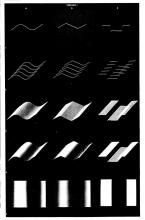Vašulka Mediascape
Woody Vašulka & Scott Nygren — “Didactic Video: Organizational Models of the Electronic Image,” (1975) — examining the “light/code interface”
Woody: “The aspect of video important to the development of these images is the light/code interface: between the segment of the electromagnetic spectrum we perceive as light, existing external to the video system, and the electronically encoded signal or waveform internal to the system. That interface normally takes place at a camera, which organizes visible reality into linear perspective by means of the camera obscura principle (dating back at least to Leonardo da Vinci) — demonstrable by a pinhole in a window shade, through which an inverted image of the outside world may be projected on the opposite wall of a darkened room. Video synthesizers, however, make possible the development of non-camera imagery, so that the electronic/light interface occurs only at the monitor, when the wave form is displayed as a visible image … Accordingly, sine, triangle, or square waves are used as the bases for most images. The didactic purpose involved is to enable the principles of time-energy construction to become common knowledge, as a primary conceptual and technological tool of our evolving electronic society.”
Woody Vašulka & Scott Nygren — “Didactic Video: Organizational Models of the Electronic Image,” in Afterimage, Rochester, NY (1975), and in Buffalo Heads, Woody Vašulka & Peter Weibel, eds, ZKM, Karlsruhe (2008); link: https://www.vasulka.org/archive/4-30c/AfterImageOct75(5024).pdf.
